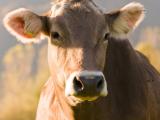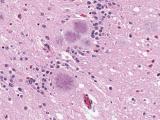Aug 4, 2005 (CIDRAP News) What looked like the possible third case of bovine spongiform encephalopathy (BSE) in the United States has now been confirmed as a false alarm, leaving the number of domestic cattle infected with the disease at two, with one of those being Canadian-born.
John Clifford, deputy adminstrator of the Animal and Plant Health Inspection Service (APHIS) announced yesterday that definitive testing of samples from the animal, performed at the Ames, Iowa, National Veterinary Services Laboratories (NVSL) and the Veterinary Laboratories Agency in Weybridge, England, showed it did not have BSE.
Initial tests Jul 27 on the 12-year-old cow, which had died during calving in April at an undisclosed location, had shown some abnormal staining that classified the results as nondefinitive and spurred the further testing. Samples from the cow had been preserved by a veterarian at the time of death but mistakenly were not sent to the US Department of Agriculture (USDA) for testing until recently.
A statement from Clifford says, "The initial non-definitive result was caused by artifactual (artificial or untrue) staining and, while this staining did not resemble BSE, we felt the prudent course was to conduct the additional tests.
"Needless to say, we are very pleased with these results. I do want to emphasize that the most important protections for human and animal health are our interlocking food-safety protocols. Our enhanced surveillance program is designed to provide information about the level of prevalence of BSE in the United States, which by any measure is extremely low."
The animal was born before the 1997 imposition of a ban on inclusion of animal protein in feed for ruminants. BSE is transmitted when cattle eat feed containing protein from a BSE-infected animal. The disease's human counterpart, variant Creutzfeldt-Jakob disease (vCJD) can occur when a person eats meat from a BSE-infected animal. The carcass of the cow just cleared of BSE did not enter the food or animal feed system.
See also:
Aug 3 APHIS press release
http://www.aphis.usda.gov/lpa/news/2005/08/negative_tt.html
Jul 28 CIDRAP News story on the earlier testing
http://www.cidrap.umn.edu/cidrap/content/other/bse/news/july2805bse.html















